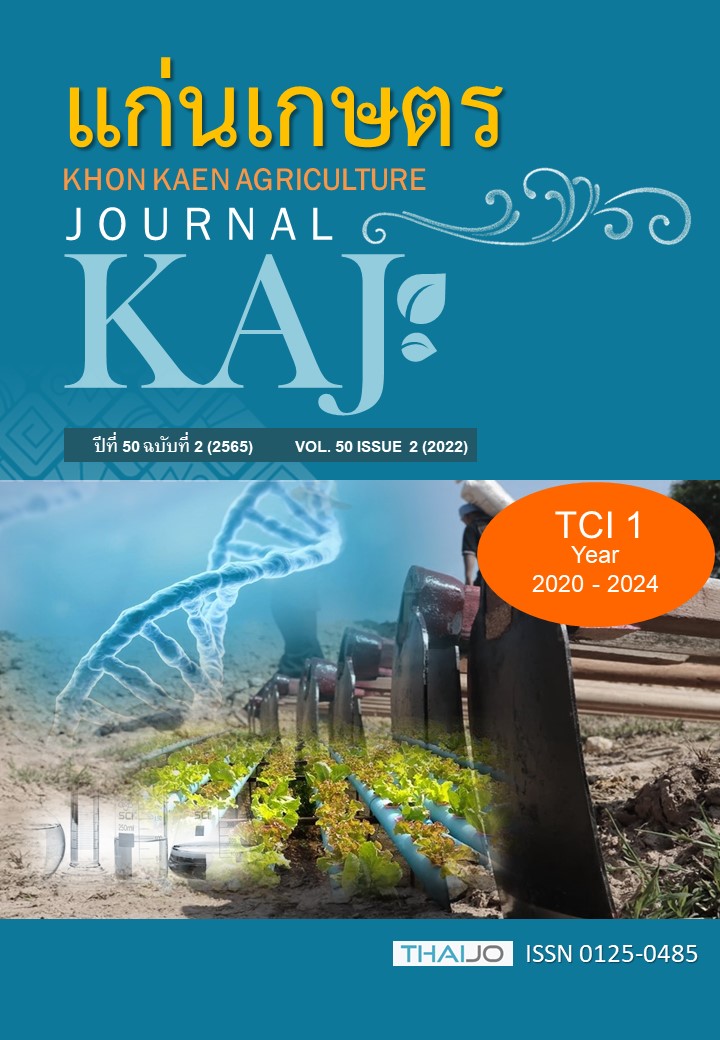ผลของระดับการเสริมน้ำสับปะรดต่อสมรรถภาพการเจริญเติบโตและลักษณะทางกายภาพของมูลในสุกรรุ่น
Main Article Content
บทคัดย่อ
การศึกษานี้มีวัตถุประสงค์เพื่อศึกษาผลของระดับการเสริมน้ำสับปะรดต่อสมรรถภาพการเจริญเติบโตและลักษณะทางกายภาพของมูลในสุกรรุ่น โดยใช้สุกรรุ่นลูกผสมสามสายพันธุ์ (แลนด์เรซ×ลาร์จไวท์×ดูร็อค) จำนวน 27 ตัว น้ำหนักตัวเริ่มต้นเฉลี่ย 24.27±5.55 กิโลกรัม สุ่มสุกรเป็น 3 กลุ่มตามระดับการเสริมน้ำสับปะรด โดยมีเพศผู้ตอนและเพศเมียในแต่ละกลุ่มทดลองจำนวนเท่า ๆ กันดังนี้ กลุ่มที่ 1 ระดับ 0 สุกรได้รับอาหารพื้นฐานที่มีกากมะพร้าว+อัตราส่วนน้ำสับปะรด:น้ำเปล่าที่ 0:1 (CM+PaJ0) กลุ่มที่ 2 ระดับ 1 สุกรได้รับอาหารพื้นฐานที่มีกากมะพร้าว+อัตราส่วนน้ำสับปะรด:น้ำเปล่าที่ 1:1 (CM+PaJ1) และกลุ่มที่ 3 ระดับ 2 สุกรได้รับอาหารพื้นฐานที่มีกากมะพร้าว+อัตราส่วนน้ำสับปะรด:น้ำเปล่าที่ 1:0 (CM+PaJ2) จากผลการศึกษาระดับการเสริมน้ำสับปะรดต่อสมรรถภาพการเจริญเติบโตของสุกรรุ่นพบว่า กลุ่มทดลองมีผลต่อสมรรถภาพการเจริญเติบโตของสุกรรุ่น โดยในสัปดาห์ที่ 2 สุกรกลุ่ม CM+PaJ2 มีอัตราการเจริญเติบโตเฉลี่ยต่อวัน (Average Daily Gain; ADG) ดีที่สุด (P=0.04) แต่กลุ่มทดลองไม่มีผลต่อปริมาณการกินอาหาร (Feed Intake; FI) และอัตราการเปลี่ยนอาหารเป็นน้ำหนักตัว (Feed Conversion Rate; FCR) (P>0.05) และเพศของสุกรมีผลต่อสมรรถภาพการเจริญเติบโต โดยสุกรเพศผู้ตอนมี ADG FCR และ FI สูงกว่าสุกรเพศเมียตลอดระยะการทดลอง (P<0.05) นอกจากนี้พบว่าระดับการเสริมน้ำสับปะรดไม่มีผลต่อลักษณะทางกายภาพและสีของมูลสุกร (P>0.05) อย่างไรก็ตามสุกรกลุ่ม CM+PaJ2 มีลักษณะของมูลในระดับเหลวและมีสีเหลืองกว่ากลุ่ม CM+PaJ1 และ CM+PaJ0 และเพศของสุกรไม่มีผลต่อลักษณะทางกายภาพและสีของมูลสุกร (P>0.05) ดังนั้นสามารถสรุปได้ว่าระดับการเสริมน้ำสับปะรดมีผลต่อสมรรถภาพการเจริญเติบโต โดยสมรรถภาพการเจริญเติบโตเพิ่มขึ้นตามระดับของการเสริมน้ำสับปะรดที่เพิ่มขึ้น โดยสุกรกลุ่ม CM+PaJ2 มีสมรรถภาพการเจริญเติบโตที่ดีที่สุด แต่ระดับการเสริมน้ำสับปะรดไม่มีผลต่อลักษณะทางกายภาพของมูลสุกรรุ่น
Article Details

อนุญาตภายใต้เงื่อนไข Creative Commons Attribution-NonCommercial-NoDerivatives 4.0 International License.
เอกสารอ้างอิง
ทินกร ทาตระกูล, วันดี ทาตระกูล และณิฐิมา เฉลิมแสน. 2553. การศึกษาส่วนผสมที่เหมาะสมของน้ำมันสะระแหน่ ฟ้าทะลายโจร และกรดซิตริค เพื่อเป็นสารเสริมในอาหารลูกสุกรหลังหย่านม. วารสารการวิจัยเพื่อพัฒนาชุมชน. 3: 41-53.
ภัทราพร ภุมรินทร์ และ สุภาวดี สืบสาย. 2554. การใช้เอนไซม์โบรมิเลนจากส่วนเหลือทิ้งสับปะรดปรับปรุงการใช้ประโยชน์ได้ของโปรตีนในกากถั่วเหลือง การย่อยได้และประสิทธิภาพการผลิตในสุกรอนุบาล. สาขาวิชาสัตวศาสตร์และเทคโนโลยีการเกษตร คณะสัตวศาสตร์และเทคโนโลยีการเกษตร, มหาวิทยาลัยศิลปากร.
วราพันธุ์ จินตณวิชญ์, อุทัย คันโธ, สุกัญญา จัตตุพรพงษ์ และปุณฑริกา หะริณสุต. 2547. การศึกษาปริมาณเอนไซม์โบรมิเลน องค์ประกอบทางเคมีจากน้ำคั้นสับปะรดและการนำไปใช้ประโยชน์ย่อยโปรตีนในกากถั่วเหลือง. น. 26-32. ใน: การประชุมทางวิชาการของมหาวิทยาลัยเกษตรศาสตร์ ครั้งที่ 42.
สาโรช ค้าเจริญ. 2542. การศึกษาการใช้วัสดุผลพลอยได้ในท้องถิ่นเป็นแหล่งอาหารทดแทนในอาหารสุกรและสัตว์ปีกของเกษตรกรรายย่อย. ภาควิชาสัตวศาสตร์ มหาวิทยาลัยขอนแก่น. ขอนแก่น.
AOAC. 1998. Official method of analysis. 15th edition, Association of official analytical chemists. Washington DC.
Corzo, C. A., K. N. Waliszewski, and J. Welti-Chanes. 2012. Pineapple fruit bromelain affinity to different protein substrates. Food Chemistry. 133: 631-635.
Dong, G., and J. Pluske. 2007. The low feed intake in newly-weaned pigs: problems and possible solutions. Asian-Australasain Journal of Animal Science. 20: 440-452.
Ettle, T., and F. X. Roth. 2004. Specific dietary selection for tryptophan by the piglet. Journal of Animal Science. 82: 1115-1121.
Hossain, M. F., S. Akhtar, and M. Anwar. 2015. Nutritional value and medicinal benefits of pineapple. International Journal of Nutrition and Food Sciences. 4: 84-88.
Jacela, J. Y., J. M. DeRouchey, M. D. Tokach, R. D. Goodband, J. L. Nelssen, D. G. Renter, and S. S. Dritz. 2010. Feed additives for swine: Fact sheets–flavors and mold inhibitors, mycotoxin binders, and antioxidants. Journal of Swine Health and Production. 18: 27-32.
Jaworski, N. W., J. Shoulders, J. C. González-Vega, and H. H. Stein. 2014. Effects of using copra meal, palm kernel expellers, or palm kernel meal in diets for weanling pigs. The Professional Animal Scientist. 30: 243-251.
Kim, H. J., S. O. Nam, J. H. Jeong, L. H. Fang, H. B. Yoo, S. H. Yoo, J. S. Hong, S. W. Son, S. H. Ha, and Y. Y. Kim. 2017. Various levels of copra meal supplementation with β-Mannanase on growth performance, blood profile, nutrient digestibility, pork quality and economical analysis in growing-finishing pigs. Journal of Animal Science and Technology. 59: 1-10.
Kraikaew, J., S. Morakul, and S. Keawsompong. 2020. Nutritional improvement of copra meal using mannanase and Saccharomyces cerevisiae. 3 Biotech. 10: 1-10.
Morales, J. I., L. Cámara, J. D. Berrocoso, J. P. López, G. G. Mateos, and M. P. Serrano. 2011. Influence of sex and castration on growth performance and carcass quality of crossbred pigs from 2 Large White sire lines. Journal of Animal Science. 89: 3481-3489.
NRC. 2012. Nutrient requirement of swine. 11th edition. National Academy Press, Washington, DC.
Patience, J. F., M. C. Rossoni-Serão, and N. A. Gutiérrez. 2015. A review of feed efficiency in swine: biology and application. Journal of Animal Science and Biotechnology. 6: 33.
Sairi, M., J. Y. Law, and M. R. Sarmidi. 2004. Chemical composition and sensory analysis of fresh pineapple juice and deacidified pineapple juice using electrodialysis. Universiti Teknologi Malaysia.
Samreen, C. V., L. Edukondalu, V. Beera, and V. S. Rao. 2020. Physicochemical Characteristics of Pomegranate and Pineapple Juice. Indian Journal of Ecology. 47: 60-63.
SAS. 2021. Statistical Analysis System: SAS User’s Guide: Statistics. SAS Institute Inc. Cary., NC. U.S.A.
Sheikh, G. G., R. P. S. Baghel, S. Nayak, B. Fatima, and A. A. Ganie. 2017. Effect of sex on growth performance, nutrient utilization and carcass characteristics in cross bred pigs. Indian Journal of Animal Research. 51: 175-178.
Stein, H. H., G. A. Casas, J. J. Abelilla, Y. Liu, and R. C. Sulabo. 2015. Nutritional value of high fiber co-products from the copra, palm kernel, and rice industries in diets fed to pigs. Journal of animal science and biotechnology. 6: 1-9.
Thorne, P., J. Wiseman, D. A. COLE, and D. Machin. 1992. Amino acid composition and aspects of protein quality in expeller copra meals for pig feeding. Tropical Science. 32: 145-151.
Torrallarodona, D., L. L. Llaurado, E. Roura, J. Matas and F. Fort. 2000. Enhancement of the performance of 21 d old weanling pigs with the addition of feed flavors. P. 346. In Abstracts of the 51st Annual Meeting of the EAAP. (Ed. J. A. M. van Arendonk, A. Hofer, Y. van der Honing, F. Mdec, K. Sejrsen, D. Pullar, L. Bodin, J. A. Fernandez and E. W. Bruns). Wageningen Pers, Wageningen.
Upadhaya, S. D., K. Y. Lee, and I. H. Kim. 2016. Effect of protected organic acid blends on growth performance, nutrient digestibility and faecal micro flora in growing pigs. Journal of Applied Animal Research. 44: 238-242.
Yun, H. M., X. J. Lei, J. Y. Cheong, J. S. Kang, and I. H. Kim. 2017. Effect of different levels of fiber and protein on growth performance and fecal characteristics in weaning pigs. Korean Journal of Agricultural Science. 44: 366-374.


